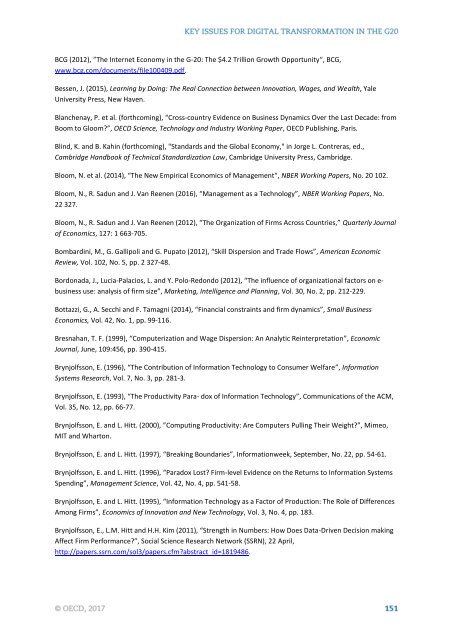KEY ISSUES FOR DIGITAL TRANSFORMATION IN THE G20
2jz0oUm
2jz0oUm
Create successful ePaper yourself
Turn your PDF publications into a flip-book with our unique Google optimized e-Paper software.
BCG (2012), ”The Internet Economy in the G-20: The $4.2 Trillion Growth Opportunity“, BCG,<br />
www.bcg.com/documents/file100409.pdf.<br />
Bessen, J. (2015), Learning by Doing: The Real Connection between Innovation, Wages, and Wealth, Yale<br />
University Press, New Haven.<br />
Blanchenay, P. et al. (forthcoming), “Cross-country Evidence on Business Dynamics Over the Last Decade: from<br />
Boom to Gloom?”, OECD Science, Technology and Industry Working Paper, OECD Publishing, Paris.<br />
Blind, K. and B. Kahin (forthcoming), "Standards and the Global Economy," in Jorge L. Contreras, ed.,<br />
Cambridge Handbook of Technical Standardization Law, Cambridge University Press, Cambridge.<br />
Bloom, N. et al. (2014), “The New Empirical Economics of Management“, NBER Working Papers, No. 20 102.<br />
Bloom, N., R. Sadun and J. Van Reenen (2016), “Management as a Technology”, NBER Working Papers, No.<br />
22 327.<br />
Bloom, N., R. Sadun and J. Van Reenen (2012), “The Organization of Firms Across Countries,” Quarterly Journal<br />
of Economics, 127: 1 663-705.<br />
Bombardini, M., G. Gallipoli and G. Pupato (2012), “Skill Dispersion and Trade Flows”, American Economic<br />
Review, Vol. 102, No. 5, pp. 2 327-48.<br />
Bordonada, J., Lucia-Palacios, L. and Y. Polo-Redondo (2012), “The influence of organizational factors on e-<br />
business use: analysis of firm size”, Marketing, Intelligence and Planning, Vol. 30, No. 2, pp. 212-229.<br />
Bottazzi, G., A. Secchi and F. Tamagni (2014), “Financial constraints and firm dynamics”, Small Business<br />
Economics, Vol. 42, No. 1, pp. 99-116.<br />
Bresnahan, T. F. (1999), “Computerization and Wage Dispersion: An Analytic Reinterpretation”, Economic<br />
Journal, June, 109:456, pp. 390-415.<br />
Brynjolfsson, E. (1996), “The Contribution of Information Technology to Consumer Welfare”, Information<br />
Systems Research, Vol. 7, No. 3, pp. 281-3.<br />
Brynjolfsson, E. (1993), “The Productivity Para- dox of Information Technology”, Communications of the ACM,<br />
Vol. 35, No. 12, pp. 66-77.<br />
Brynjolfsson, E. and L. Hitt. (2000), ”Computing Productivity: Are Computers Pulling Their Weight?”, Mimeo,<br />
MIT and Wharton.<br />
Brynjolfsson, E. and L. Hitt. (1997), “Breaking Boundaries”, Informationweek, September, No. 22, pp. 54-61.<br />
Brynjolfsson, E. and L. Hitt. (1996), “Paradox Lost? Firm-level Evidence on the Returns to Information Systems<br />
Spending”, Management Science, Vol. 42, No. 4, pp. 541-58.<br />
Brynjolfsson, E. and L. Hitt. (1995), “Information Technology as a Factor of Production: The Role of Differences<br />
Among Firms”, Economics of Innovation and New Technology, Vol. 3, No. 4, pp. 183.<br />
Brynjolfsson, E., L.M. Hitt and H.H. Kim (2011), “Strength in Numbers: How Does Data-Driven Decision making<br />
Affect Firm Performance?”, Social Science Research Network (SSRN), 22 April,<br />
http://papers.ssrn.com/sol3/papers.cfm?abstract_id=1819486.


